Killer Vampire Photography – Royal Blood by Erwin Olaf (GALLERY)
Posted in: UncategorizedBrussels Biennial: a quick walk through
Posted in: Uncategorized Previously: Brussels Biennial: Lufthansa Deportation Class.
Previously: Brussels Biennial: Lufthansa Deportation Class.
Why a biennial in Brussels in 2008? Lazy answer: because every country has an art biennial so why shouldn’t Belgium have one?
Lengthier answer:
The a first reason is geographical: Brussels is positioned in the deeply urbanized region encompassing a large part of North-Western Europe which Rem Koolhaas calls the Hollocore.
As AMO explains: While Europe was once the birthplace of the metropolis, the future of the modern city is now being defined in the developing world. (…) Where the cities in the developing world explode into bigger, less containable metropolitan areas, urban Europe is in a state of entropy. No longer energized by growth, cities and towns drift off into a muddle of provincial sameness, leaving an urban vacuum. But, of course, modernity abhors a vacuum, and an infinite multiplicity of new forms of urbanity emerges to take the place of what has become redundant.
The HOLLOCORE© is emblematic of Europe’s new urbanity — the amorphous super-region that links Brussels, Amsterdam, and the Ruhr Valley is urban Europe’s non-event: it houses 32 Million inhabitants or 9% of Europe’s population, yet has no city larger than one million inhabitants. Two thirds of its population lives in cities smaller then 200,000 inhabitants — in places no one has ever heard of.
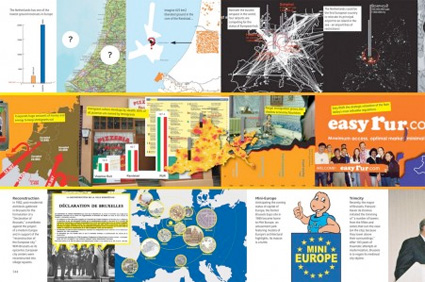
Image AMO
This contemporary urban landscape is a territorial metaphor of the European project: with no dominant cultural identity, devoid of a major city center and with no overarching governance.
A second motivation for the event is the birthday of Brussels Expo ’58, which closed its doors almost exactly 50 years before the Brussels Biennial opened. For many people the Expo ’58 introduced the notion of ‘modernity.’
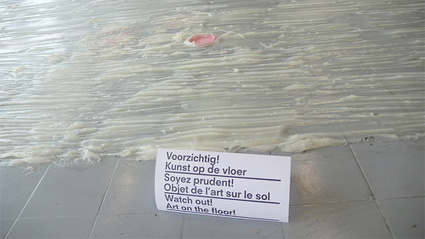
Despite all its claims to be a truly multi-cultural and international city, Brussels cannot abstract itself from the national context. Which brings me to the third reason for the Biennial: as with all things Belgian, there is a political purpose (the event is “An initiative of the Flemish Community”). But that’s a long story that passionates only the most Belgians among us and i must admit that my inability to take a clear stand puts me in the shoes of a second-class Belgian.
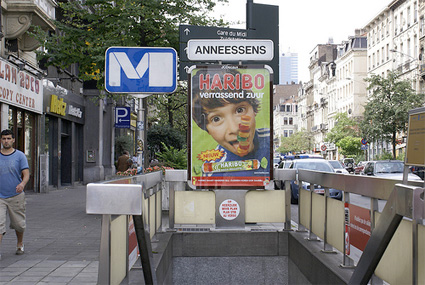
Anneessens (premetrostation). Photo © 2008 Tine Claerhout
The two main venues for the Biennale ‘re-use’ modernity. One is the ex-Post Sorting Centre which re-opened exclusively for the Biennial. The second one was a depressing corridor inside the Anneessens metro station. I might seen to grumble and snivel but i actually liked that biennial a lot. It was surprising, bold and intelligent if a little bit too much on the shambles side.
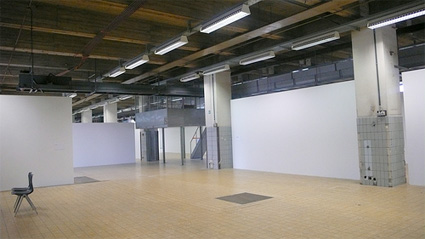
The start of my visit was fairly bleak. The first exhibition i saw at the ex-Post Sorting Centre was Once is Nothing, made of ‘physically absent’ artworks. Not that this would put me off, i managed to enjoy the Sao Paulo Biennial after all. Once is Nothing is based on a previous show, ‘Individual Systems’ part of the 2003 edition of the Venice Biennale . Devoid of any art piece, the room is nevertheless supposed to be ‘full of memories and history.’ The exhibition is a pertinent comment on the impossibility to replicate exactly one exhibition and on the pointless demand for innovation that characterizes most art biennials.
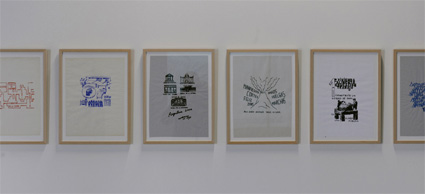
Taller Popular de Serigrafía – photo ©2008 Manfred Jade
Things got seriously interesting further on with the Taller Popular de Serigrafia (Popular Silkscreen Workshop), a collective of artists and designers born with the protest movements in the wake of Argentina’s economic collapse of December 2001. TPS is part of a long history weaving political activism and graphic arts in Latin America (the collective’s name is inspired by the early 20th century Taller de Gráfica Popular in Mexico).
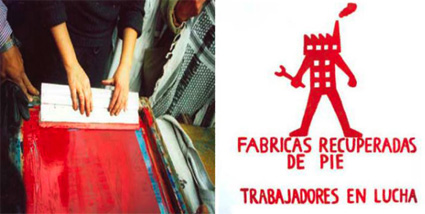
Image bola de nieve
TPS uses silk-screen printing as an affordable type of art to react quickly to political events and collaborate with different social movements. While they take part in acts and demonstrations they draw images on the clothes of the street protesters, create billboards, murals, posters and leaflets. Not only does TPS turn their works into an instrument of social struggle, they also make an act of creativity out of their protests as their creations are preserved after their original use and collected outside of the revolutionary context.
The designs are usually simple, monochrome and direct. Their drawings, diagrams and occasionally photographic images often culture jam the logos and colors of soccer clubs or of other political propaganda.
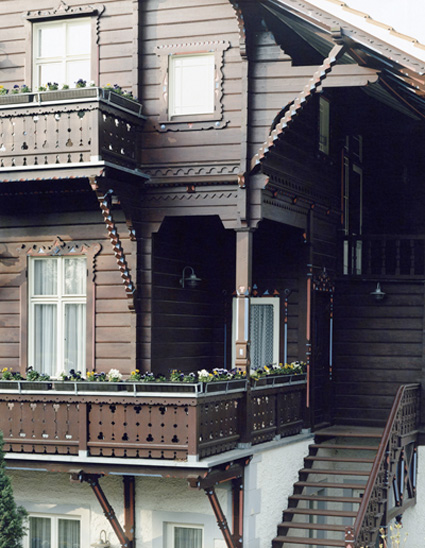
Ferienhaus, Heringsdorf, Maxim Gorkistrasse, Wolgaster Holzindustrie Aktiengesellschaft, 1900, Courtesy Johann König, Berlin
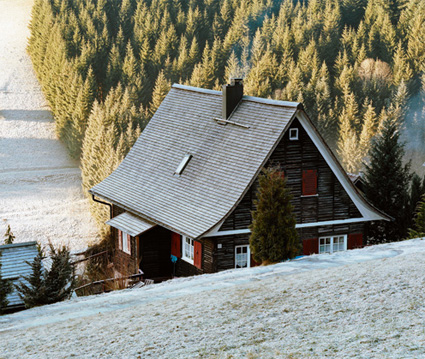
Annette Kelm, Prefabricated House, Reinerzau, 2008. Courtesy Marc Foxx, Los Angeles and Johann König, Berlin
Annette Kelm‘s series Prefabricated Houses investigates the history of prefab houses, as developed from the late 19th century to the 1930s in Germany. The clichéd ‘Swiss’ chalets and ‘Swedish’ villas were designed by different architects and mass produced by factories during a time of housing shortage. The houses were affordable and could be dismantled without too much time nor effort. Intrigued by the high level of ornamentation displayed on each house, Kelm’s photographs reveal a transition of industry and craft, functionality and fashion. By bringing together the notion of ready-made sculpture with the utopian ideals of modernist architecture, perhaps Kelm is suggesting the changed, if not compromised, contemporary position of both (via.)
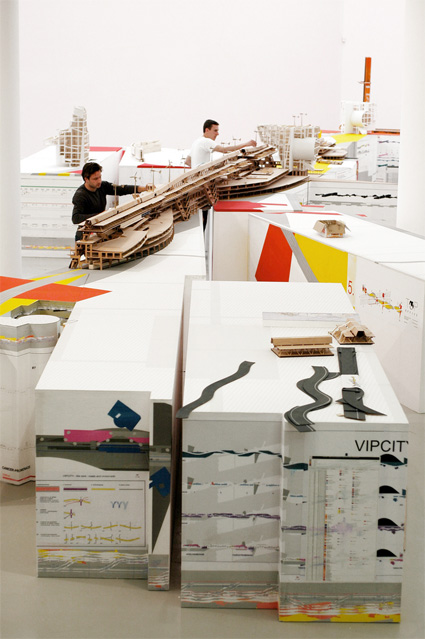
Luc Deleu, VIPCITY, 1999-2004. Photo © 2004 Clinckx
One of the most formidable works on show was the 18,5 m long scale-model ‘Vipcity’ by Luc Deleu. The architect and urbanist has been working on a half-visionary half-utopian concept of ‘Unadapted City’ for some 12 years. Since living on the planet earth has become problematic due to a lack of space, urban spaces ought to be used in a more polyvalent manner. Deleu accordingly proposes an interconnected building activity that pervades the entire city and is aimed at offering the greatest possible freedom to individual initiatives at the micro level. The proposed volumes are the result of a study of the necessary surface and infrastructure: an adequate number of cinemas have been planned, but they can also be used as sports hall, mushroom farm or accommodation for hamadryas baboons (no, i don’t know either what the baboons are doing here.)
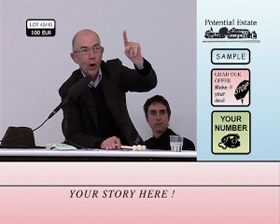 The Crying of Potential Estate is a film developed by Potential Estate from a scenario for a real-time auction. A story written by Potential Estate was cut up into 45 lots and put up for sale in January 2008. After a lot was read from an audio-booth, the bidding started.
The Crying of Potential Estate is a film developed by Potential Estate from a scenario for a real-time auction. A story written by Potential Estate was cut up into 45 lots and put up for sale in January 2008. After a lot was read from an audio-booth, the bidding started.
As the lots were sold a story gradually unfolded. The story is set partly in the village of Belgium, Wisconsin and features The Indian, the tiny economist and Wally Hope. Wally Hope refers to a man who became an icon of freedom in the mid-70ties. After the auction it emerges that The Crying of Potential Estate is also the mediated version of the above auction. It was screened live from a mini TV-studio Potential Estate had set up in the basement gallery. In fact all visitors present on the evening of the auction shift position from extras in the film to actors playing the role of accomplices to a long-drawn murder.
Potential Estate will offer the film The Crying of Potential Estate as a Gift to the Village of Belgium, WI (USA). The Gift, certified by an attorney at law, will be made possible by a number of private shareholders.
The Crying of Potential Estate – lot #5
There is much more to say about the Biennale, how i discovered the stunning work of Juliaan Schillemans and how i finally managed to see (and like) Letter to Leopold, Extra City‘s contribution to the Biennial.
See also Pierre Clemens’ video about the Brussels Biennial.
My flickr set.
The Brussels Biennial runs until January 4, 2009.
Best wishes and a tour of your favourite posts in 2008
Posted in: UncategorizedHappy new year dear readers!
2008 has been a bit of a ‘detox’ year for wmmna as i’ve been slowly drifting away from what had made the success (it’s all relativity) of my blog: new media art. 6 months ago i didn’t think i would write this but here we go: ‘i’m starting to miss you, new media art. I still have my doubts and a few issues to settle with you but i would love it if you could give me another try.’
Some of you might have noticed that the rss feed of wmmna is severely ill. It’s been almost 3 weeks already. We are trying to fix it so bear with us.
Let’s kick off this year with a top 10 of the stories which you have clicked the most in 2008. Starting with a quick comment on the categories you’ve most perused: architecture (yes! yes! good choice!), sex (can’t pretend i’m much surprised), then design (a category i’ve been trying to kill for almost 2 years now but it appears to be much stronger than i), art from japan, installation, wearable, art in berlin, art, gadgets and finally my new favourite: activism.
Now for the most popular posts:
Virtual Transgender Suit, avatar termination and other online world tales
Robot ‘plays back’ dreams
Automatic door… Japan style (an oldie from 2005)
24c3: The history of guerilla knitting
Pricked: Extreme Embroidery
Interview with Riitta Ikonen
DIY tractor culture in Poland
SUPERDOME at the Palais de Tokyo
Conflux: Vertical Bed
and Visualizing: tracing an aesthetics of data.
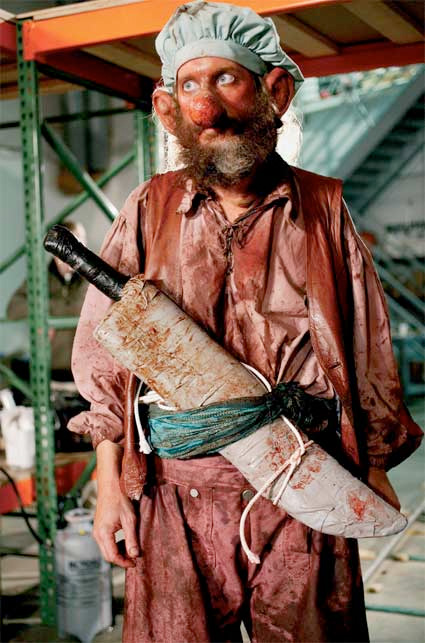
Caribbean Pirates, 2001-05. Courtesy Hauser & Wirth
I couldn’t help but think at what my own top 10 would be. I was unable to list my 10 favourite posts of 2008 but i can tell you which exhibition has blown me away like nothing else ever did before. It was the Paul McCarthy retrospective at the S.M.A.K. I wish i could see that one again and again. I wish i could blog it again.
HSBC Investment: Marilyn, Beatles
Posted in: UncategorizedAdvertising Agency: JWT, São Paulo, Brazil
Chief Creative Officer: Mario D’Andrea
Creative Directors: Mario D’Andrea, Roberto Fernandez
Art Director: Pedro Izique
Copywriter: Gustavo Gusmão
Photographer: Rogério Miranda
AbuKass Rice | Everyday is a Special Day
Posted in: UncategorizedMiraculous Antique SuperCars – ‘Lost’ 1937 Bugatti Type 57S Atalante Will Fetch Millions (VIDEO)
Posted in: UncategorizedCyberpunk Risque Editorials – Naomi Campbell is a Futuristic Lady (GALLERY)
Posted in: UncategorizedNudevertising in 2009 – Fashion Photogs Want Naughty and Nice (GALLERY)
Posted in: UncategorizedFuturistic Dream Cars – Awesome Automotive Marvels With Back Stories (GALLERY)
Posted in: UncategorizedCampbell Soup is Food Marketer of the Year
Posted in: Uncategorized Campbell Soup is no doubt the food marketer of the years, fending off the various factors that included a declining economy while maintaining its brand class compared to other products trying to survive by compromising their actual products. The rise of raw materials was something to worry about but what operations had to deal with was compensated by analytical and strategic marketing that included a head-on collision with General Mills’ Progresso.
Campbell Soup is no doubt the food marketer of the years, fending off the various factors that included a declining economy while maintaining its brand class compared to other products trying to survive by compromising their actual products. The rise of raw materials was something to worry about but what operations had to deal with was compensated by analytical and strategic marketing that included a head-on collision with General Mills’ Progresso.
Soup-wise, the company’s condensed business saw some softness last year as price increases impacted volume, but Campbell responded swiftly with a multimedia campaign that reminded consumers of the iconic products’ value as a nutritious, low-cost meal solution.
(Source) Marketing Daily
Packaging Milk
Posted in: UncategorizedUne sélection d’excellents packagings à découvrir dans la suite sur des bouteilles de laits. La plupart sont conçus en point de croix, de manière très créatives par le studio Hattomonkey.



Dans le même esprit : Visual Advice
DHL’s fortune cookie
Posted in: UncategorizedClick Image To Enlarge & Read Rationale
Agency: OctOpus, Dubai, UAE
Creative Director: Stu Higton
Art Director: Josef Domer
Via [ Dubai Lynx Website ]
Heather Locklear Headed Back to Melrose Place?
Posted in: Uncategorized If rumors are true, we may see the return of original cast member Heather Locklear at Melrose Place once again. Reports have it that the Locklear was approached on reviving her old role as Amanda Woodward but she has yet to reply.
If rumors are true, we may see the return of original cast member Heather Locklear at Melrose Place once again. Reports have it that the Locklear was approached on reviving her old role as Amanda Woodward but she has yet to reply.
The possible return of Locklear is expected to be a big boost to Melrose Place which is most probably looking for something juicy to add to its fold. Will Locklear be back?
E! Online’s inside sources say Heather has been approached to revive her role as “conniving advertising vixen” Amanda Woodward, but Heather’s rep says she hasn’t.
(Source) Examiner.com
Clever Adtography – Ken Anderson’s Amusing Photographic Campaigns (GALLERY)
Posted in: UncategorizedJPG Magazine Closing Down Next Week
Posted in: Uncategorized After AsianWeek had announced it was releasing its last issue today, another magazine has announced that it will be closing down next week. PG Magazine, a print and Web publication featuring pictures contributed by amateur and professional photographers, is likewise shutting down.
After AsianWeek had announced it was releasing its last issue today, another magazine has announced that it will be closing down next week. PG Magazine, a print and Web publication featuring pictures contributed by amateur and professional photographers, is likewise shutting down.
Similar to the reasoning behind AsianWeek, the financial turmoil has been identified as the culprit. In recent months, the future and status of most publications have been raised in light of the new mode of delivering information through the web and adding the economic crisis to the mix was just too much for publications we are all familiar with. Who could be next?
(Source) AFP
Sleazevertising – American Apparel Starts 2009 with a Bang (GALLERY)
Posted in: UncategorizedOrigami creativity
Posted in: UncategorizedSipho Mabona is an origami artist. Origami, the ancient Japanese art of paper folding, can create stunning video commercials when combined with stop motion recording. This video, created for Asics by Sipho’s company Mabona Origami, won several international prizes.
Have a look at some other creations by the same artist at his Flickr photostream or this profile page.















